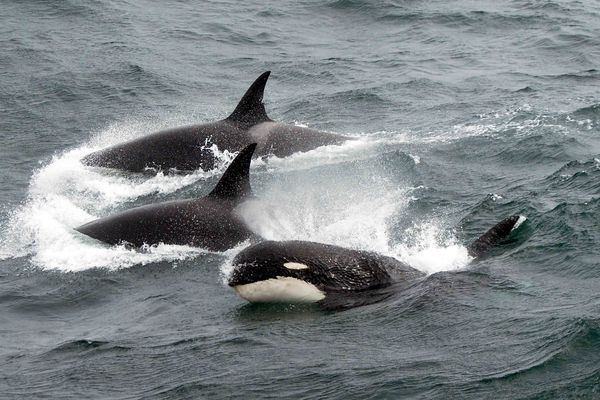Rare Breed of Killer Whale May Be New Species
Type D killer whales—a rare subspecies once thought to be a genetic anomaly—in the sub-Antarctic.
Other subspecies of killer whale have different eyespots. Photograph by Frans Lanting, National Geographic
A group of killer whales once thought to be genetic anomalies may in fact be a species all their own, according to a recent study in the journal Polar Biology.
The rarely-seen "type D" orcas—which live in the Southern Ocean—are one of four varieties of killer whale. Researchers recently sequenced type D's genome using material collected from a museum skeleton from 1955.
Scientists first spotted type D killer whales in 1955, when a pod of them washed ashore on a New Zealand beach. The stranding stood out as unusual because of the whales' strange appearance. While typical killer whales—types A, B, and C—have streamlined bodies and large, white eye-patches, type D whales have tiny eye markings and large, bulbous heads.
The type D pod's stranding resulted in a handful of photos and the collection of one skeleton by the Museum of New Zealand Te Papa Tongarewa in Wellington.
According to Robert Pitman, a marine biologist at the U.S. National Marine Fisheries Service, and a co-author of the new study, for many years researchers thought the whales were the result of genetic mutations because there were no other known sightings.
But some 50 years after the New Zealand stranding, a group of researchers, including Pitman, took a closer look at the documentation of the event. They unearthed other accounts of the weird whales, and found that the New Zealand pod was not the only sighting in history.
"We started seeing photos of this type of animal from various places, all around the Antarctic waters," Pitman said. "The weather is bad down there all the time," he said. "That's why the whale escaped notice from scientists for so many years."
In 2010, these findings led Pitman and colleagues to publish a study about the newly acknowledged whales' unique appearance.
Though the physical differences of type D killer whales were apparent, the researchers needed to do genetic testing to figure out if it was a new species. But the variety of whale is so rarely spotted that a fresh tissue sample was unlikely.
So they turned to the next best thing: the 50-year-old skeleton that was collected by the New Zealand museum.
"We were really fortunate that someone had foresight to collect this sample and save it," said Phillip Morin, a marine biologist with the U.S. Southwest Fisheries Science Center in La Jolla, California, and a co-author of the study.
Scientists used a portion of the whale's skeleton to map type D's genome. They then compared their results with the genomes of the more common orcas—types A, B, and C—to determine the genetic differences among all four varieties.
The study revealed that type D's genetic differences date back nearly 400,000 years. These ancient variations may qualify type D as an entirely new species or subspecies of killer whale, though further evidence will be needed before the proposal is confirmed.
In the meantime, there are many more killer whales to study, according to Morin.
"There's a lot more diversity out there than we even know about yet," he said. "We still haven't even begun to sample large parts of the world where killer whales exist."
Lara Sorokanich
National Geographic
Published June 27, 2013













